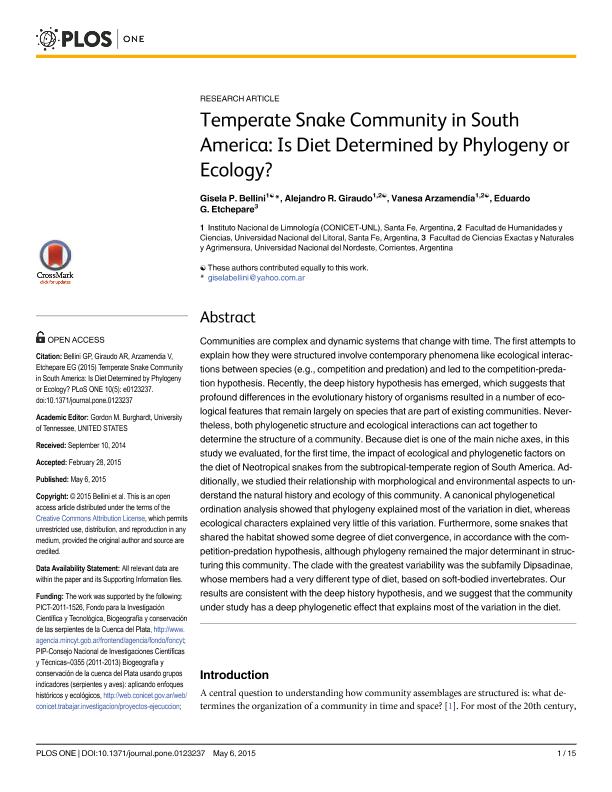Mostrar el registro sencillo del ítem
dc.contributor.author
Bellini, Gisela Paola

dc.contributor.author
Giraudo, Alejandro Raul

dc.contributor.author
Arzamendia, Vanesa

dc.contributor.author
Etchepare, Eduardo Gabriel

dc.date.available
2018-02-26T18:07:44Z
dc.date.issued
2015-05
dc.identifier.citation
Bellini, Gisela Paola; Giraudo, Alejandro Raul; Arzamendia, Vanesa; Etchepare, Eduardo Gabriel; Temperate snake community in South America: Is diet determined by phylogeny or ecology?; Public Library of Science; Plos One; 10; 5; 5-2015; 1-15; e0123237
dc.identifier.issn
1932-6203
dc.identifier.uri
http://hdl.handle.net/11336/37109
dc.description.abstract
Communities are complex and dynamic systems that change with time. The first attempts to explain how they were structured involve contemporary phenomena like ecological interactions between species (e.g., competition and predation) and led to the competition-predation hypothesis. Recently, the deep history hypothesis has emerged, which suggests that profound differences in the evolutionary history of organisms resulted in a number of ecological features that remain largely on species that are part of existing communities. Nevertheless, both phylogenetic structure and ecological interactions can act together to determine the structure of a community. Because diet is one of the main niche axes, in this study we evaluated, for the first time, the impact of ecological and phylogenetic factors on the diet of Neotropical snakes from the subtropical-temperate region of South America. Additionally, we studied their relationship with morphological and environmental aspects to understand the natural history and ecology of this community. A canonical phylogenetical ordination analysis showed that phylogeny explained most of the variation in diet, whereas ecological characters explained very little of this variation. Furthermore, some snakes that shared the habitat showed some degree of diet convergence, in accordance with the competition-predation hypothesis, although phylogeny remained the major determinant in structuring this community. The clade with the greatest variability was the subfamily Dipsadinae, whose members had a very different type of diet, based on soft-bodied invertebrates. Our results are consistent with the deep history hypothesis, and we suggest that the community under study has a deep phylogenetic effect that explains most of the variation in the diet.
dc.format
application/pdf
dc.language.iso
eng
dc.publisher
Public Library of Science

dc.rights
info:eu-repo/semantics/openAccess
dc.rights.uri
https://creativecommons.org/licenses/by-nc-sa/2.5/ar/
dc.subject
Temperate Snake Community
dc.subject
Community Structure
dc.subject
Diet
dc.subject
Ecology
dc.subject.classification
Otras Ciencias Biológicas

dc.subject.classification
Ciencias Biológicas

dc.subject.classification
CIENCIAS NATURALES Y EXACTAS

dc.title
Temperate snake community in South America: Is diet determined by phylogeny or ecology?
dc.type
info:eu-repo/semantics/article
dc.type
info:ar-repo/semantics/artículo
dc.type
info:eu-repo/semantics/publishedVersion
dc.date.updated
2018-02-22T21:04:43Z
dc.journal.volume
10
dc.journal.number
5
dc.journal.pagination
1-15; e0123237
dc.journal.pais
Estados Unidos

dc.journal.ciudad
San Francisco
dc.description.fil
Fil: Bellini, Gisela Paola. Consejo Nacional de Investigaciones Científicas y Técnicas. Centro Científico Tecnológico Conicet - Santa Fe. Instituto Nacional de Limnología. Universidad Nacional del Litoral. Instituto Nacional de Limnología; Argentina
dc.description.fil
Fil: Giraudo, Alejandro Raul. Consejo Nacional de Investigaciones Científicas y Técnicas. Centro Científico Tecnológico Conicet - Santa Fe. Instituto Nacional de Limnología. Universidad Nacional del Litoral. Instituto Nacional de Limnología; Argentina
dc.description.fil
Fil: Arzamendia, Vanesa. Consejo Nacional de Investigaciones Científicas y Técnicas. Centro Científico Tecnológico Conicet - Santa Fe. Instituto Nacional de Limnología. Universidad Nacional del Litoral. Instituto Nacional de Limnología; Argentina
dc.description.fil
Fil: Etchepare, Eduardo Gabriel. Consejo Nacional de Investigaciones Científicas y Técnicas. Centro Científico Tecnológico Conicet - Santa Fe. Instituto Nacional de Limnología. Universidad Nacional del Litoral. Instituto Nacional de Limnología; Argentina
dc.journal.title
Plos One

dc.relation.alternativeid
info:eu-repo/semantics/altIdentifier/doi/http://dx.doi.org/10.1371/journal.pone.0123237
dc.relation.alternativeid
info:eu-repo/semantics/altIdentifier/url/http://journals.plos.org/plosone/article?id=10.1371/journal.pone.0123237
Archivos asociados
